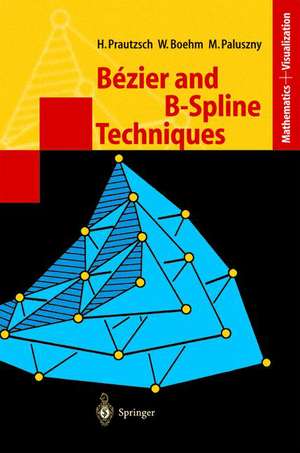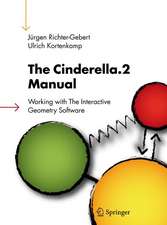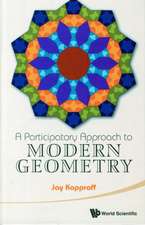Bézier and B-Spline Techniques: Mathematics and Visualization
Autor Hartmut Prautzsch, Wolfgang Boehm, Marco Palusznyen Limba Engleză Hardback – 6 aug 2002
| Toate formatele și edițiile | Preț | Express |
|---|---|---|
| Paperback (1) | 523.81 lei 6-8 săpt. | |
| Springer Berlin, Heidelberg – 5 dec 2010 | 523.81 lei 6-8 săpt. | |
| Hardback (1) | 698.01 lei 6-8 săpt. | |
| Springer Berlin, Heidelberg – 6 aug 2002 | 698.01 lei 6-8 săpt. |
Din seria Mathematics and Visualization
- 20%
 Preț: 919.40 lei
Preț: 919.40 lei -
 Preț: 256.43 lei
Preț: 256.43 lei - 18%
 Preț: 944.71 lei
Preț: 944.71 lei - 18%
 Preț: 1091.66 lei
Preț: 1091.66 lei - 24%
 Preț: 800.85 lei
Preț: 800.85 lei - 15%
 Preț: 643.60 lei
Preț: 643.60 lei - 18%
 Preț: 1199.96 lei
Preț: 1199.96 lei - 20%
 Preț: 980.55 lei
Preț: 980.55 lei - 20%
 Preț: 977.49 lei
Preț: 977.49 lei - 15%
 Preț: 634.60 lei
Preț: 634.60 lei - 20%
 Preț: 1262.78 lei
Preț: 1262.78 lei - 20%
 Preț: 645.63 lei
Preț: 645.63 lei - 20%
 Preț: 468.67 lei
Preț: 468.67 lei - 20%
 Preț: 1251.59 lei
Preț: 1251.59 lei - 15%
 Preț: 638.60 lei
Preț: 638.60 lei - 20%
 Preț: 329.75 lei
Preț: 329.75 lei - 20%
 Preț: 636.06 lei
Preț: 636.06 lei - 20%
 Preț: 640.77 lei
Preț: 640.77 lei - 20%
 Preț: 646.92 lei
Preț: 646.92 lei - 18%
 Preț: 1203.08 lei
Preț: 1203.08 lei - 20%
 Preț: 328.14 lei
Preț: 328.14 lei - 5%
 Preț: 1082.99 lei
Preț: 1082.99 lei - 20%
 Preț: 975.69 lei
Preț: 975.69 lei - 18%
 Preț: 1215.50 lei
Preț: 1215.50 lei - 20%
 Preț: 1139.02 lei
Preț: 1139.02 lei - 20%
 Preț: 330.66 lei
Preț: 330.66 lei - 20%
 Preț: 975.51 lei
Preț: 975.51 lei - 20%
 Preț: 637.52 lei
Preț: 637.52 lei - 18%
 Preț: 947.65 lei
Preț: 947.65 lei - 15%
 Preț: 642.97 lei
Preț: 642.97 lei - 20%
 Preț: 975.19 lei
Preț: 975.19 lei - 18%
 Preț: 941.91 lei
Preț: 941.91 lei
Preț: 698.01 lei
Preț vechi: 872.51 lei
-20% Nou
Puncte Express: 1047
Preț estimativ în valută:
133.58€ • 139.51$ • 110.75£
133.58€ • 139.51$ • 110.75£
Carte tipărită la comandă
Livrare economică 11-25 februarie 25
Preluare comenzi: 021 569.72.76
Specificații
ISBN-13: 9783540437611
ISBN-10: 3540437614
Pagini: 320
Ilustrații: XIV, 304 p.
Dimensiuni: 155 x 235 x 22 mm
Greutate: 0.63 kg
Ediția:2002
Editura: Springer Berlin, Heidelberg
Colecția Springer
Seria Mathematics and Visualization
Locul publicării:Berlin, Heidelberg, Germany
ISBN-10: 3540437614
Pagini: 320
Ilustrații: XIV, 304 p.
Dimensiuni: 155 x 235 x 22 mm
Greutate: 0.63 kg
Ediția:2002
Editura: Springer Berlin, Heidelberg
Colecția Springer
Seria Mathematics and Visualization
Locul publicării:Berlin, Heidelberg, Germany
Public țintă
Professional/practitionerCuprins
1 Geometric fundamentals.- 2 Bézier representation.- 3 Bézier techniques.- 4 Interpolation and approximation.- 5 B-spline representation.- 6 B-spline techniques.- 7 Smooth curves.- 8 Uniform subdivision.- 9 Tensor product surfaces.- 10 Bézier representation of triangular patches.- 11 Bézier techniques for triangular patches.- 12 Interpolation.- 13 Constructing smooth surfaces.- 14 Gk-constructions.- 15 Stationary subdivision for regular nets.- 16 Stationary subdivision for arbitrary nets.- 17 Box splines.- 18 Simplex splines.- 19 Multivariate splines.- References.
Recenzii
From the reviews:
This excellent book gives a well-focused introduction to the essential concepts of computer aided geometric design. The authors provide a solid and unified derivation of the various properties of Bézier and B-spline representations. These piecewise polynomial representations have become the major tool to handle curves and surfaces in various applications, such as computer-aided design and computer graphics. In addition, the authors discuss a number of advanced concepts, including multivariate splines, certain subdivision techniques, and free-form surface splines. [...]
The material presented in this book is visualized by many carefully prepared figures, which will be of great help for understanding the theoretical concepts. In addition, the authors have provided a number of useful exercises (without solutions). The book can be used as a textbook for courses at the graduate and intermediate undergraduate levels, for students of mathematics, computer science and engineering, and for self study. It will also be a useful reference book for researchers and practitioners in the field of computer aided geometric design and its various applications.
Bert Jüttler, AMS 2004
"The book provides a clear and illustrative presentation of the basic principles in computer-aided geometric design. It is addressed mainly to the students and teachers in mathematics, computer science and engineering sciences. At the end of each chapter several problems are proposed." (Dana Petcu, Zentralblatt MATH, Vol. 1033 (8), 2004)
"The book provides a basic presentation of the most important techniques in Computer-aided Geometric Design. The illustrative style gives a clear understanding of the subject and makes it well suited for students or lecturers in mathematics and computer sciences. … Each chapter comes with a small supplement of exercises." (H. G. Feichtinger, Monatshefte für Mathematik, Vol. 142 (3),2004)
"This excellent book gives a well-focused introduction to the essential concepts of computer aided geometric design. … The material presented in this book is visualized by many carefully prepared figures, which will be of great help for understanding the theoretical concepts. In addition, the authors have provided a number of useful exercises. The book can be used as a textbook … . It will also be a useful reference book for researchers and practitioners in the field of computer aided geometric design … ." (Bert Jüttler, Mathematical Reviews, 2004 e)
"Computer Aided Geometric Design (CAGD) deals with the algorithmic aspects of curves and surfaces. … the book definitely serves as a solid introduction to recent literature on CAGD. It is based on courses taught by the authors, and the book shows that the material has been thoroughly tested and revised in classrooms. … The book is highly recommended, both as a textbook for courses on geometric computing and as a self-contained introduction to the field of Computer Aided Geometric Design." (G. Vegter, Nieuw Archief voor Wiskunde, Vol. 7 (2), 2006)
This excellent book gives a well-focused introduction to the essential concepts of computer aided geometric design. The authors provide a solid and unified derivation of the various properties of Bézier and B-spline representations. These piecewise polynomial representations have become the major tool to handle curves and surfaces in various applications, such as computer-aided design and computer graphics. In addition, the authors discuss a number of advanced concepts, including multivariate splines, certain subdivision techniques, and free-form surface splines. [...]
The material presented in this book is visualized by many carefully prepared figures, which will be of great help for understanding the theoretical concepts. In addition, the authors have provided a number of useful exercises (without solutions). The book can be used as a textbook for courses at the graduate and intermediate undergraduate levels, for students of mathematics, computer science and engineering, and for self study. It will also be a useful reference book for researchers and practitioners in the field of computer aided geometric design and its various applications.
Bert Jüttler, AMS 2004
"The book provides a clear and illustrative presentation of the basic principles in computer-aided geometric design. It is addressed mainly to the students and teachers in mathematics, computer science and engineering sciences. At the end of each chapter several problems are proposed." (Dana Petcu, Zentralblatt MATH, Vol. 1033 (8), 2004)
"The book provides a basic presentation of the most important techniques in Computer-aided Geometric Design. The illustrative style gives a clear understanding of the subject and makes it well suited for students or lecturers in mathematics and computer sciences. … Each chapter comes with a small supplement of exercises." (H. G. Feichtinger, Monatshefte für Mathematik, Vol. 142 (3),2004)
"This excellent book gives a well-focused introduction to the essential concepts of computer aided geometric design. … The material presented in this book is visualized by many carefully prepared figures, which will be of great help for understanding the theoretical concepts. In addition, the authors have provided a number of useful exercises. The book can be used as a textbook … . It will also be a useful reference book for researchers and practitioners in the field of computer aided geometric design … ." (Bert Jüttler, Mathematical Reviews, 2004 e)
"Computer Aided Geometric Design (CAGD) deals with the algorithmic aspects of curves and surfaces. … the book definitely serves as a solid introduction to recent literature on CAGD. It is based on courses taught by the authors, and the book shows that the material has been thoroughly tested and revised in classrooms. … The book is highly recommended, both as a textbook for courses on geometric computing and as a self-contained introduction to the field of Computer Aided Geometric Design." (G. Vegter, Nieuw Archief voor Wiskunde, Vol. 7 (2), 2006)
Caracteristici
Modern, graduate-level book on computer aided geometric design Includes supplementary material: sn.pub/extras























